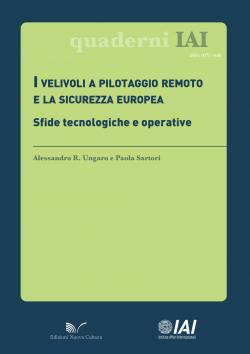I velivoli a pilotaggio remoto e la sicurezza europea. Sfide tecnologiche e operative
The Remotely Piloted Aircraft Systems (RPAS), both fixed and rotary wing, have proved to be an increasingly useful asset for a broad spectrum of non-military operations aimed to guarantee the national and European security. In this view, the volume examines the RPAS from three different perspectives, providing: an analysis of hypothetical operational scenarios within the civil/security scope; an examination of the principal aspects and the potential vulnerabilities of the cyber domain; and, finally, some future perspectives in terms of market and technological development as well as the RPAS integration in the non-segregated airspace and within the ATM environment. From the analysis emerges how, in front of potential advantages deriving from the use of RPAS, still some diverse critical issues remain, requiring the adoption of a coordinated, harmonic and synergic approach between the numerous interested stakeholders, both civil and military. The aim is to guarantee the growth of the RPAS segment inside a single European RPAS market, ensuring at the same time the respect of adequate protection and security standards for European citizens.
Volume produced within the framework of the research project "The Remotely Piloted Aircraft Systems (RPAS) and the European security", and presented at the conference "I velivoli a pilotaggio remoto. Una nuova frontiera per la protezione e la sicurezza" organised in Rome on 26 July 2016.
-
Details
Roma, Nuova Cultura, July 2016, 134 p. -
In:
-
Issue
16 -
ISBN/ISSN/DOI:
978-88-6812-708-4
Introduzione
Lista degli acronimi
1. La sicurezza europea e i velivoli a pilotaggio remoto: alcune ipotesi di impiego
1.1 L’impiego dei velivoli a pilotaggio remoto: considerazioni preliminari
1.2 Ipotesi di impiego dei velivoli a pilotaggio remoto in ambito civile/sicurezza
1.2.1 Sorveglianza delle frontiere terrestri e marittime
1.2.2 Supporto ad operazioni di varia natura delle Law Enforcement Agencies (LEAs)
1.2.3 Supporto ad operazioni di ricerca e soccorso
1.2.4 Monitoraggio delle infrastrutture critiche, di siti nucleari e/o impianti industriali di rilevanza strategica
1.2.5 Supporto ad operazioni in caso di disastri naturali e/o antropici e supporto alle reti di comunicazione
1.3 Prospettive di impiego da parte di agenzie europee
1.3.1 Gli APR per la sorveglianza delle frontiere
1.3.2 Gli APR a supporto di operazioni in caso disastri naturali e/o antropici
2. Aspetti e vulnerabilità dei velivoli a pilotaggio remoto nel dominio cyber
2.1 Cybersecurity e APR: vulnerabilità e tipologie di attacco
2.2 Sicurezza delle comunicazioni nei collegamenti C2 e protezione delle informazioni derivanti dalle attività svolte con gli APR
2.3 Aspettative e considerazioni sulle capacità automatiche e autonome dei velivoli a pilotaggio remoto
3. Prospettive future per i velivoli a pilotaggio remoto
3.1 Le prospettive di mercato e sviluppo tecnologico dei velivoli a pilotaggio remoto
3.2 L’integrazione dei velivoli a pilotaggio remoto nello spazio aereo non segregato e l’inserimento in ambiente ATM: elementi tecnologici e cooperazione civile-militare
Bibliografia
Topic
Tag
Related content
-
Event14/07/2016
I velivoli a pilotaggio remoto
leggi tutto -
Ricerca28/06/2016
The Remotely Piloted Aircraft Systems (RPAS) and the European security
leggi tutto



